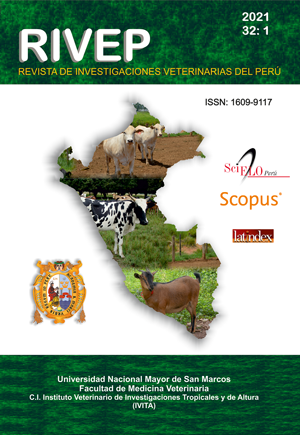Application of near infrared spectroscopy – NIRS – to determine the nutritional value of varieties of alfalfa (Medicago sativa L) and red clover (Trifolium pretense L)
DOI:
https://doi.org/10.15381/rivep.v32i1.19491Keywords:
NIRS, calibration, legume, proximal analysis, neutral detergent fibreAbstract
The aim of this study was to determine the applicability of near infrared spectroscopy (NIRS) for the nutritional assessment of two important forage species in the country: alfalfa (Medicago sativa L) and red clover (Trifolium pratense L). For this, 75 samples of alfalfa varieties (SW 8210, WL 625HQ) and 75 of red clover varieties (Quiñequeli, Kendland) obtained from the paddocks of the IVITA El Mantaro Experimental Station, Junín region, Peru were used. Proximal analysis was performed determining the content of crude protein (CP), ether extract (EE), crude fibre (CF), total ash (TA) and neutral detergent fibre (NDF), and the spectrum was captured using NIRS equipment. The calibration and validation models were developed to estimate the predictive capacity using Partial Least Squares (PLS), and the accuracy and precision statistics used were the Correlation Coefficient (R), Determination Coefficient (R2), Root Mean Square Error of Calibration (RMSEC), Root Mean Square of Prediction Error (RMSEP), Ratio of Range to Error (RER) and Residual Predictive Deviation (RPD). The mathematical models obtained showed that the NIRS technique has a good predictive capacity for the nutritional components of CP, TA and NDF (R2: 0.97, 0.99, 0.94; RPD: 2.00, 2.17 and 2.00, respectively) for varieties of alfalfa and red clover.
Downloads
Downloads
Published
Issue
Section
License
Copyright (c) 2021 Carlos Estupiñán M., Fernando Carcelén C., Víctor Hidalgo L., David Rojas E., Oscar Vera C., Sofía López G., Sandra Bezada Q.

This work is licensed under a Creative Commons Attribution-NonCommercial-ShareAlike 4.0 International License.
AUTHORS RETAIN THEIR RIGHTS:
a. Authors retain their trade mark rights and patent, and also on any process or procedure described in the article.
b. Authors retain their right to share, copy, distribute, perform and publicly communicate their article (eg, to place their article in an institutional repository or publish it in a book), with an acknowledgment of its initial publication in the Revista de Investigaciones Veterinarias del Perú (RIVEP).
c. Authors retain theirs right to make a subsequent publication of their work, to use the article or any part thereof (eg a compilation of his papers, lecture notes, thesis, or a book), always indicating the source of publication (the originator of the work, journal, volume, number and date).










